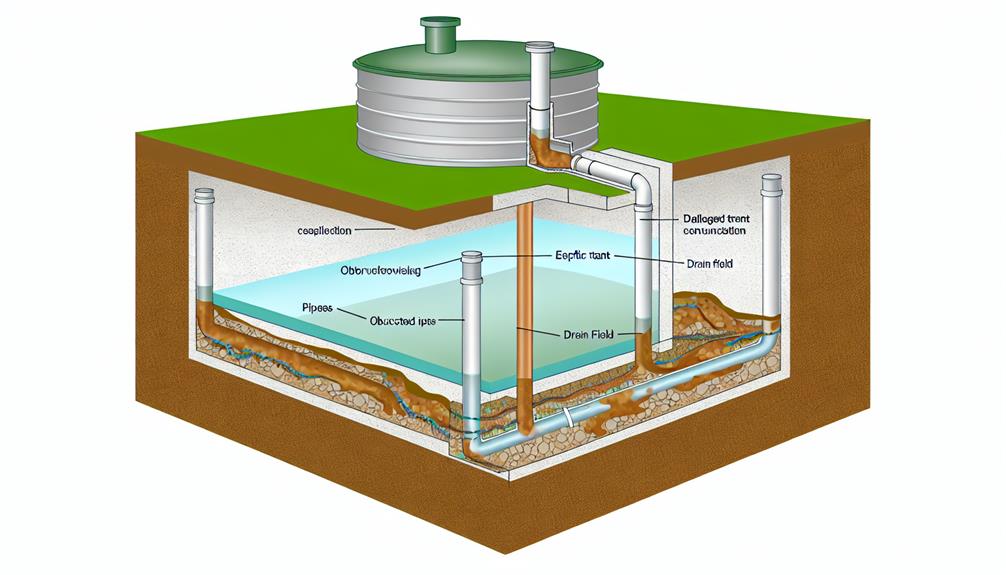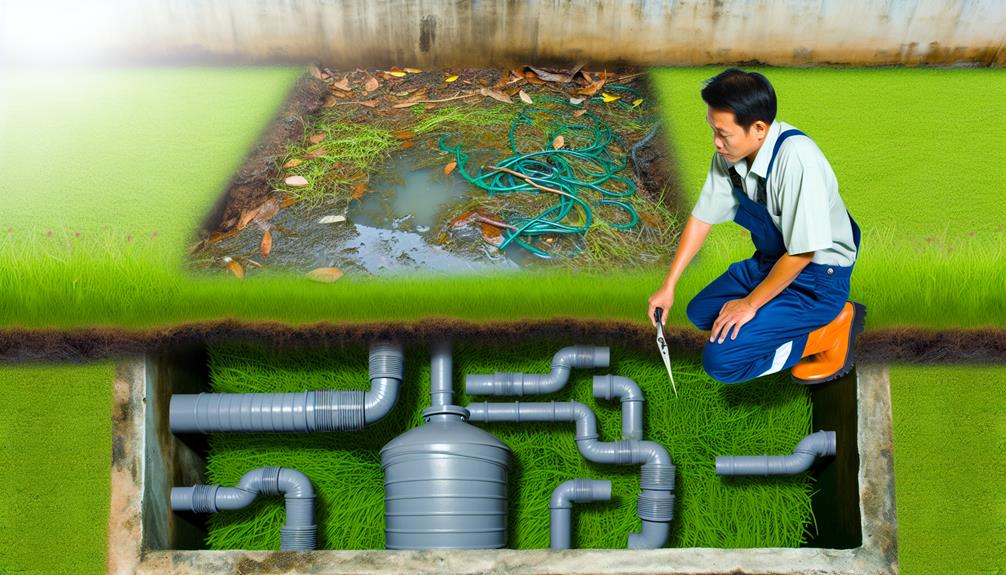Discover how to protect your septic system from breakdown with...
Read MoreYou & Your Septic Tank
6 Best Solutions for Frequent Septic Tank Pumping Issues
Our professional septic service team offers comprehensive septic tank pumping services to keep your system running smoothly. Get a FREE Quote Today.

6 Best Solutions for Frequent Septic Tank Pumping Issues
Imagine this: you’ve just come home from a long day at work, only to be greeted by the unpleasant smell of a backed-up septic system. It’s a situation you wouldn’t wish on your worst enemy, and it’s one you’ve found yourself dealing with more often than you’d like.
You’re not alone, though. Many homeowners struggle with frequent septic tank pumping issues, but there are solutions out there. By understanding the root causes of these issues and how to effectively address them, you can prevent these inconvenient, and sometimes costly, mishaps from happening again.
Stick around and we’ll explore the six best tactics you won’t want to miss out on.
Key Takeaways
- Regular maintenance and inspections are crucial for identifying and addressing septic tank problems.
- Promptly addressing blockages and clogs ensures optimal septic system functionality.
- Drain field issues should be handled promptly to maintain septic system health.
- Recognizing and acting promptly in the event of a septic tank overflow is essential to mitigate damage and restore functionality.
Identifying Common Septic Tank Problems

In managing your septic tank, it’s crucial to identify and address common problems such as foul odors, slow drainage, and lush green grass over the drain field, all of which can indicate serious issues. These symptoms often suggest a tank reaching its capacity or inadequate waste decomposition.
Your tank’s capacity isn’t just about size; it’s also about how much waste your household generates. If you’re experiencing problems, it might be time to reassess your tank’s size relative to your household’s requirements. You might be surprised to learn that you’re simply overloading the system.
Waste decomposition is another key factor in septic system health. The bacteria in your tank break down waste, but if the bacteria can’t keep up with the waste volume, you’ll run into problems. Slow decomposition can result in a buildup of sludge, leading to blockages and overflows.
Overcoming Blockages and Clogs
When you’re faced with blockages and clogs in your septic system, it’s essential to act promptly to prevent further complications. Ignoring the problem won’t make it disappear, instead, it may exacerbate the situation leading to more costly repairs. So, what’s the best approach to overcome blockages and clogs?
- Investigate the Cause: Start by identifying the root cause of the clog. This could range from non-degradable waste to tree roots interfering with the piping.
- Pipe Replacement: If the blockage is severe, the affected pipes may need to be replaced. This is a complex task that should be handled by professionals to ensure the system functions optimally post-replacement.
- Use Eco-Friendly Products: To prevent future clogs, consider using eco-friendly products that break down easily and won’t damage your septic system. These are typically free of harsh chemicals and are safe for both your septic tank and the environment.
Fixing Drain Field Issues

Drain field issues can significantly disrupt your septic system’s functionality, so it’s crucial to address them promptly and effectively. A common problem is soil absorption issues, where the soil in your drain field becomes clogged or compacted, preventing the effluent from your septic tank from being adequately absorbed.
To alleviate this, consider drain field rejuvenation. This process involves injecting high-pressure water or air into the soil to break up compaction and clogs. It’s a non-invasive procedure that can revitalize your drain field without the need for extensive digging or replacement.
However, rejuvenation isn’t always the answer. If your drain field’s problems stem from poor design or installation, you might need to consider more comprehensive solutions. For instance, re-routing your system or installing a new drain field might be necessary.
Handling Septic Tank Overflows
When it comes to managing your septic system, the unexpected overflow of your septic tank can pose a serious challenge.
It’s vital to familiarize yourself with the common symptoms of an overflow, so you can act promptly when such issues arise.
Let’s explore immediate solutions to tackle this problem, ensuring the longevity and efficiency of your septic tank system.
Identifying Overflow Symptoms
Recognizing the signs of a septic tank overflow early on can help you nip potential issues in the bud, saving you from costly repairs and unsanitary conditions. It’s essential to know the overflow indicators and foresee the overflow consequences.
Here are three significant overflow symptoms you should watch out for:
- Unpleasant Odors: If you’re smelling sewage inside or outside of your home, it could be a sign of overflow.
- Slow Drains: If your sinks, showers, or toilets are draining slower than usual, your septic tank could be at capacity.
- Lush Lawn: A suddenly green and lush lawn over your drain field could indicate a septic tank overflow.
Act quickly when you notice these signs to prevent further damage and ensure a healthy, functioning septic system.
Immediate Overflow Solutions
Having identified these key signs of a septic tank overflow, it’s crucial to act promptly, employing immediate solutions to mitigate damage and restore your system’s functionality. Emergency response measures should be your first resort. Contact a professional septic service for immediate assistance. They’ve the expertise to handle the situation safely and efficiently.
Next, implement overflow management techniques. If possible, limit your water usage to prevent further spillage. This includes avoiding laundry, dishwashing, and long showers until the issue is resolved. Remember, each gallon of water you save lessens the overflow’s severity.
Lastly, never attempt to clean up the mess yourself. Septic waste is hazardous and requires professional handling. By following these steps, you’ll effectively manage septic tank overflows.
Preventing Unpleasant Odors

To prevent unpleasant odors emanating from your septic tank, it’s crucial to understand the root causes and implement regular maintenance strategies. Odor neutralization techniques and airflow improvement methods are two key components to consider.
- Odor Neutralization: The first step is to use odor neutralization techniques. This usually involves adding bacterial additives to your septic tank. These additives break down the waste and reduce the production of foul-smelling gases. You can add these additives to your tank regularly as part of your maintenance routine.
- Airflow Improvement: Ensuring proper ventilation in your septic system is also vital in controlling odors. This can be achieved through regular inspections and maintenance of your septic system’s vents. Blocked or damaged vents can trap gases inside the tank, causing unpleasant odors.
- Regular Pumping: Lastly, don’t overlook the importance of regular septic tank pumping. This removes the solid waste that, if left for too long, can decompose and produce foul smells.
Being proactive in your septic tank maintenance not only prevents odors but also extends the life of your system. Remember, a well-maintained septic tank is a less smelly one.
Regular Maintenance and Inspection Tips
While keeping odors at bay is a significant part of septic tank management, it’s also essential to focus on regular maintenance and inspections to ensure your system’s overall health and longevity. The inspection frequency of your septic tank largely depends on its size, usage, and age. Generally, it’s recommended to have it inspected at least once every three years.
Regular inspections help identify potential issues before they escalate and thus, reduce maintenance costs in the long run.
Proper maintenance of your septic system includes regular pumping to remove sludge and scum, which if left unchecked, can cause blockages and system failure. Be proactive about this; don’t wait until you have a problem. The cost of a septic tank pump-out varies, but investing in this service is less expensive than the cost of replacing a failed septic system.
Lastly, consider using septic tank additives. They can boost the bacterial population in the tank, aiding in the breakdown of waste. This isn’t a substitute for regular pumping, but it can complement your maintenance efforts.
Conclusion
In handling septic tank issues, it’s not just about fixing problems; it’s about preventing them. Tackle blockages swiftly, address drain field issues decisively, and manage overflows with urgency.
But remember, prevention is juxtaposed with cure. Keep odors at bay with proactive measures, and don’t underestimate the power of regular maintenance and inspections.
It’s through this balance of immediate action and ongoing prevention that you’ll keep your septic system in peak condition.
You may also like...
Why Are DIY Fixes Essential for Septic Tank Pumping?
Tap into the importance of DIY fixes for septic tank...
Read MoreUnveiling the Average Costs of Septic Tank Pumping
Master the mysteries of septic tank pumping costs and avoid...
Read More
The Best Septic Tank Pumping Services Near You

Answer Some Questions
Let us know about your needs so we can find you the right septic tank pros.

Get Quotes
We will put you in touch with the right septic tank pros for your job and location.

Hire Right
Compare quotes, message or call pros, and hire only when ready.



